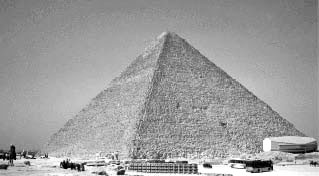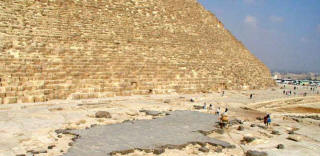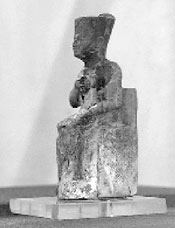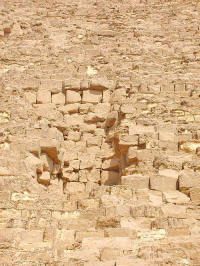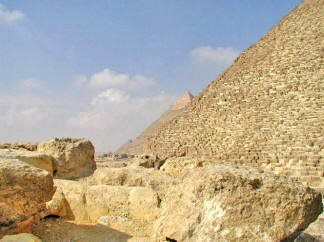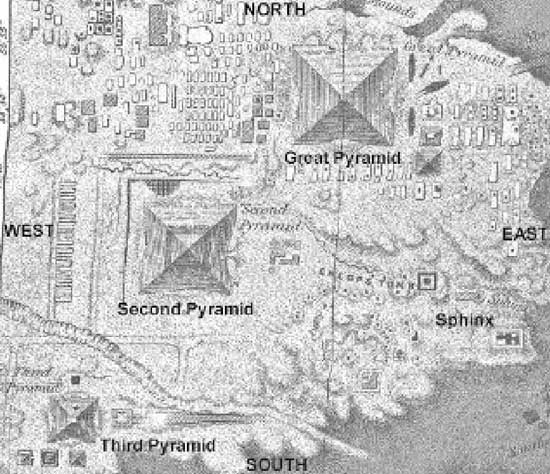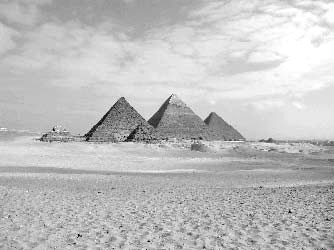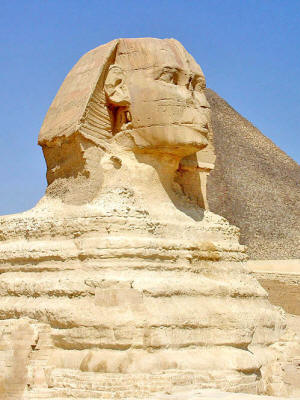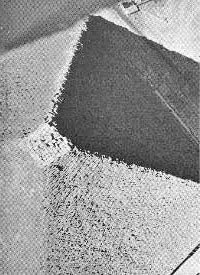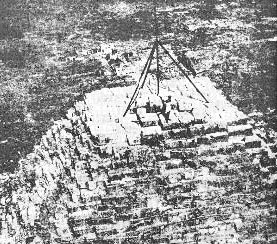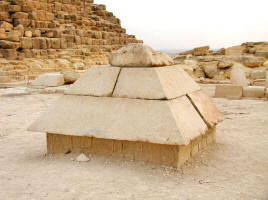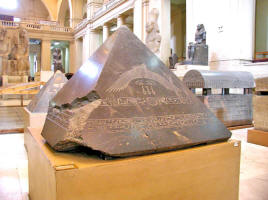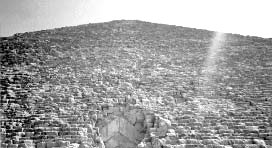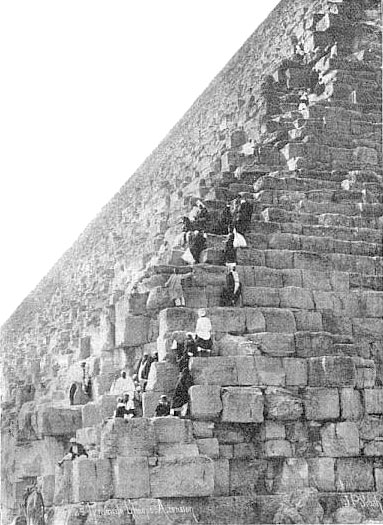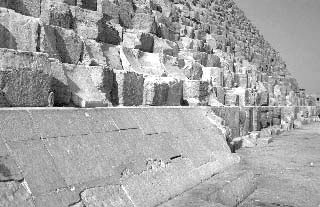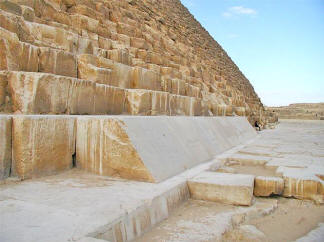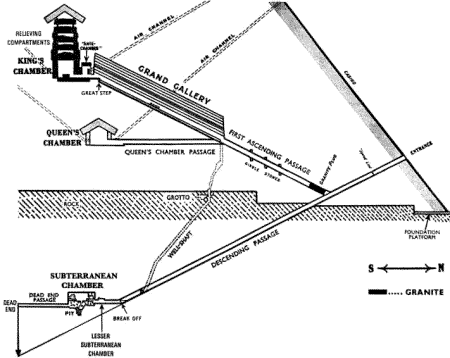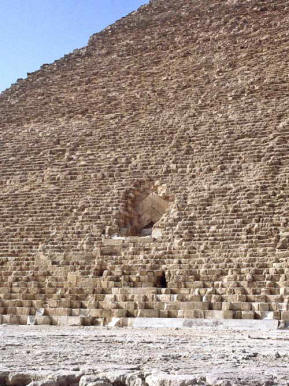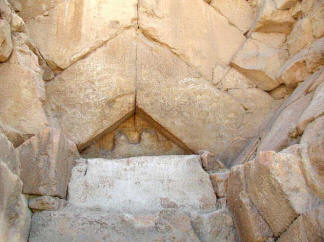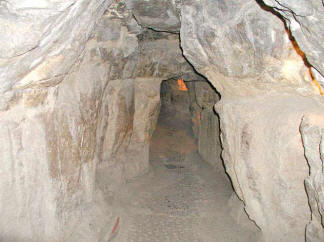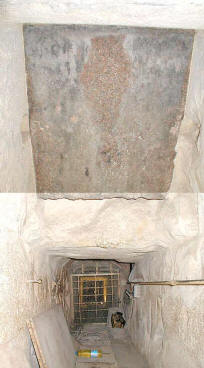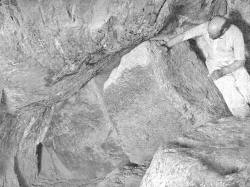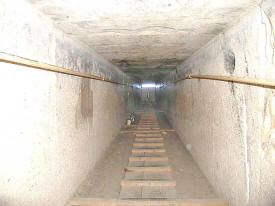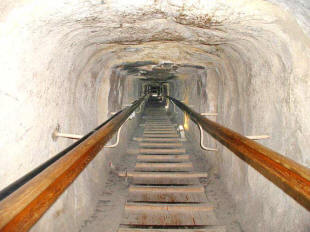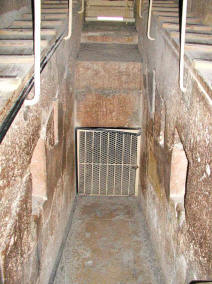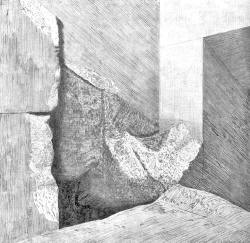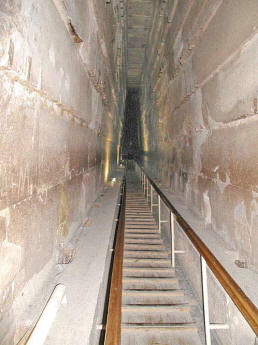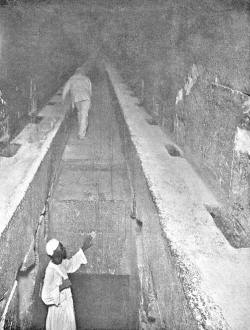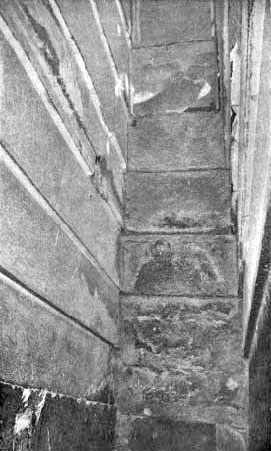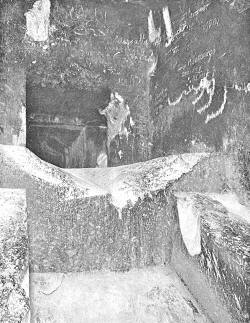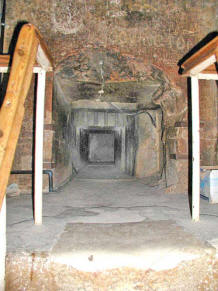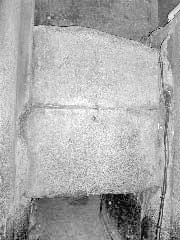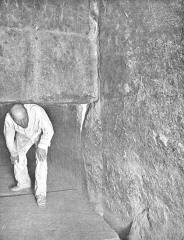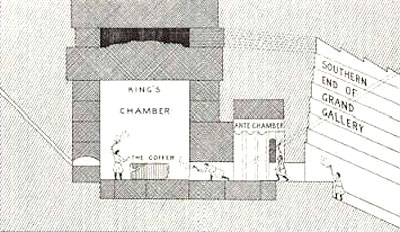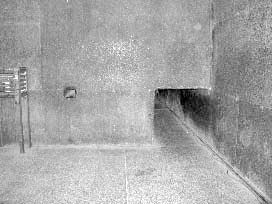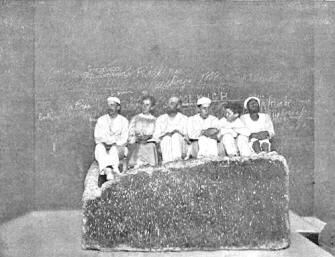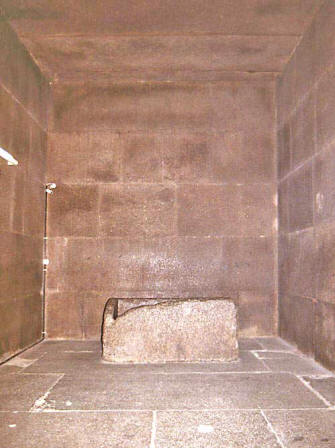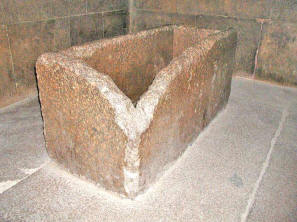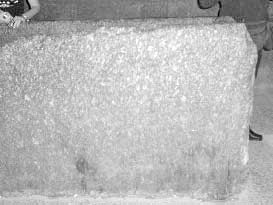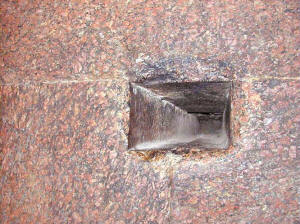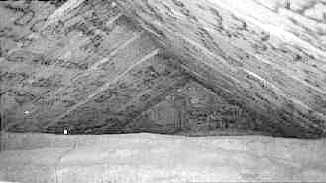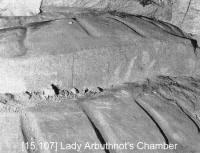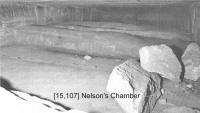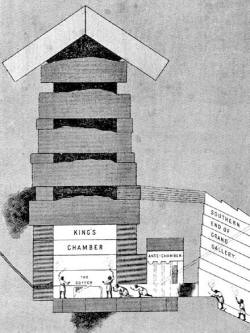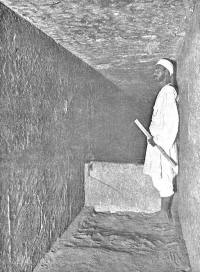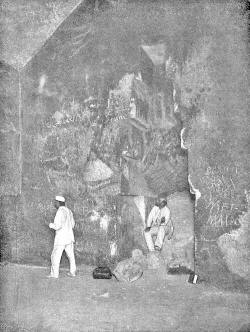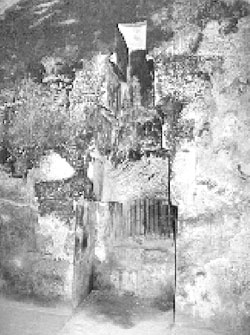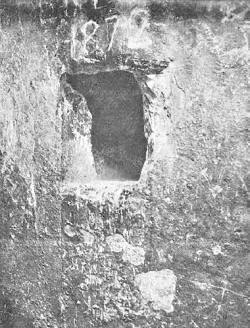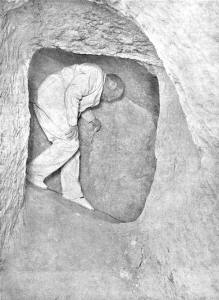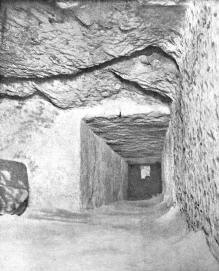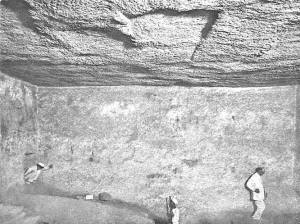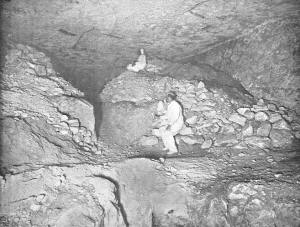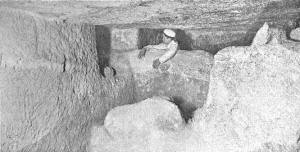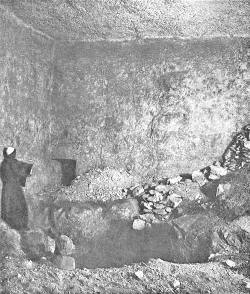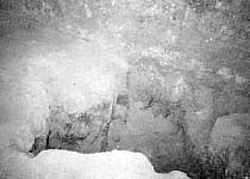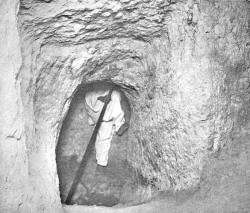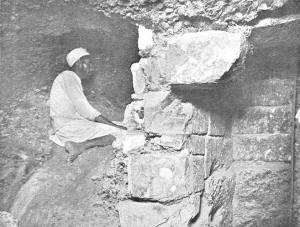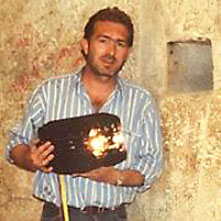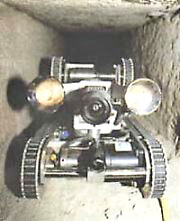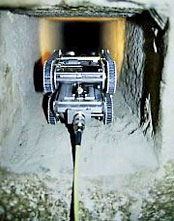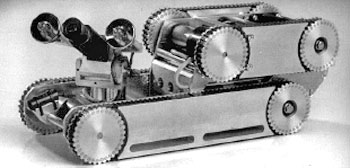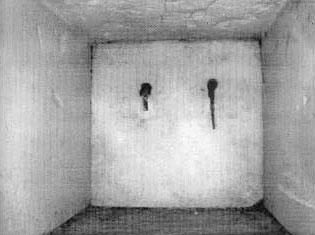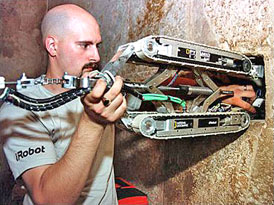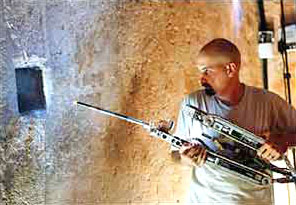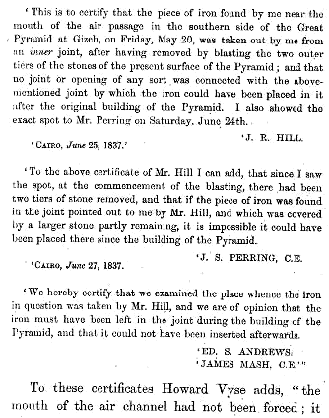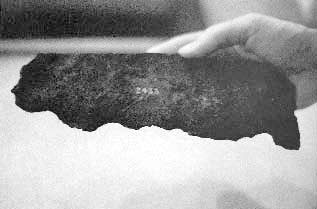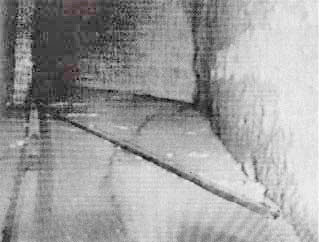|
It has been calculated that the original pyramid with its casing stones would have acted like a gigantic mirror and reflect light so powerful that it would be visible from the moon as a shining star on earth.
The Great Pyramid of Giza is the only remaining and oldest of the 7 wonders of the ancient world. It stands majestically on the northern edge of the one square mile Giza Plateau. It is 10 miles west of Cairo on the eastern extremity of the Libyan section of the Sahara Desert on the west bank of the Nile.
There are currently 203 courses or steps to its summit and each of the four triangular sides slope upward at an angle of about 52 degrees (more precise 51 degrees 51 minutes 14.3 seconds). The joints between adjacent blocks fit together with optical precision and less than 1/50 of an inch separates individual blocks. The cement that was used is extremely fine and strong and defies chemical analysis. It also appears that if pressure is applied, the blocks will break before the cemented joints.
Today, with all our modern science and engineering, we would not be able to build a Great Pyramid of Giza.
East side of the Great Pyramid James Ferguson, in his great work, the History of Architecture, describes the Great Pyramid as,
The pyramid is oriented to true north with a greater accuracy than any known monument, astronomical site, or any other building in the world. Today, the most accurate north oriented structure is the Paris observatory which is 6 minutes of a degree off true north. The Great Pyramid of Giza is only 3 minutes of a degree off true north. Studies have shown that these 3 minutes off true north may be due to either a shift in the earth’s pole or movement of the African continent. Thus, when first built, it may have been perfectly oriented to true north.
A small ivory figure of the Pharaoh Khufu
in the Cairo Museum Others researchers question this date since erosion studies on the Giza plateau indicate that the Great Pyramid is much older. In fact, some researchers have proposed that it may be thousands of years older than the currently accepted date. See Articles B and D. Either way, it was the most magnificent structure in the ancient world.
Colonel Vyse, in his explorations in the 1800’s, used blasting with gunpowder to try to find hidden entrances and chambers.
A huge and ugly 30-foot scar that he produced in his attempt to find a hidden entrance on the south side of the Great Pyramid can be seen very visibly today
Damage on the south side
caused by Colonel Vyse Next to the Great Pyramid stand two additional large pyramids. Academic Egyptologists attribute the slightly smaller one (471 feet high) to Khufu’s son and successor, Chephren (Khafra).
It still has its upper casing stones intact. The other, much smaller (213 feet high), sheathed in red granite, is traditionally attributed to Chephren’s successor, the grandson of Khufu, Mykerinus (Menkaura).
The Three Giza Pyramids
with the South Eastern corner of the Great
Pyramid in the foreground It may appear that the 2nd pyramid (Chephren’s) is larger than the Great Pyramid. Chephren’s pyramid is 471 feet high.
The Great Pyramid originally with its capstone would have been 484 feet high. So, in its original state it would have been about 13 feet higher than Chephren’s Pyramid. But, the Great Pyramid is missing its capstone, which currently makes it 454 feet high and smaller than Chephen’s (since the capstone would have added about 30 feet to its height).
Map of the Giza Plateau
Chephren’s pyramid in the Middle with casing
stones at the top A very prominent and well-known feature on the Giza Plateau is the famous Sphinx. Attributed to the Pharaoh Kephren, there is much debate about its age. The Sphinx lies about 1200 feet southeast of the Great Pyramid and is a magnificent site to behold.
It was carved from the sandstone hill and is about 240 feet long, 66 feet high, and about 13 feet wide. It is thought that originally it was painted in many different colors.
The four faces of the pyramid are slightly concave, which is not apparent to the naked eye. Sir Flinders Petrie noted this hollowing on each face of the pyramid and it was as much as 37 inches on the northern face. This effect is only visible from the air and under certain lighting conditions and lines of sight.
Because of this hollowing, a shadow appears at dawn and sunset on the equinoxes on the southern face of the Great Pyramid. But remember, the finished pyramid was covered with casing stones and this effect would not be produced. No one knows why this precision indentation was built into each side knowing that the pyramid would be finally covered with casing stones. It is very interesting that Petrie found no evidence of this hollowing on the lower casing stones that were still intact.
Arial photograph – east side in shade
This mast is still present.
Usually, when a pyramid was constructed, the top part or capstone was the last thing to be placed on it. The remains of a ‘pyramidion’ was discovered on the Giza plateau in the 1980’s.
It probably belonged to a small satellite pyramid.
‘Pyramidion’ discovered at Giza The capstone was considered the most important part of the pyramid and was made of special stone or even gold and also highly decorated.
Capstones from other pyramids have been found and one is shown below.
The Pyramidion of the Pharaoh Amenemhat III.
12th Dynasty Whether the Great Pyramid was intentionally built without a capstone, or never was finished, or it was stolen or destroyed is unknown. But the accounts of visitors to the pyramid from the ancient past (as far back as the time of Christ) always reported that the pyramid lacked a capstone.
Being a scientist, Siemen then moistened a newspaper and wrapped it around the wine bottle to convert it into a Leyden jar (an early form of a capacitor). When he held it above his head, it became charged with electricity. Sparks were then emitted from the bottle. One of the Arab guides got frightened and thought Siemen was up to some witchcraft and attempted to seize Siemen’s companion. When Siemen’s noticed this, he pointed the bottle towards the Arab and gave him such a shock that it knocked the Arab to the ground almost rendering him unconscious.
Philo of Byzantium compiled the list of the 7 wonders of the ancient world in the 2nd century B.C. The Great Pyramid of Giza was named as the first wonder of the ancient world and the only one still remaining to this day.
The other wonders are:
Tourists climbing the Great Pyramid in the early 1900’s
These stones came from the quarries of Tura and Masara in the Moqattam Hills on the opposite side of the Nile. These casing stones reflected the sun’s light and made the pyramid shine like a jewel. The ancient Egyptians called the Great Pyramid “Ikhet”, meaning the “Glorious Light”. At the present, only a few of these are left in position on each side at the base.
The Arabs stripped off most of them in the 14th century after an earthquake loosened many. They cut them up to build mosques and buildings in Cairo. One of the largest remaining casing stones is nearly 5 feet high by 8 feet and weighs about 15 tons.
How these blocks were transported and assembled remains a mystery. To manufacture just two blocks with a tolerance of .010 inch and place them together with a gap of no more than .020 inch is a remarkable feat.
The Great Pyramid had at one time over 100,000 similar casing stones.
Casing Stones Herodotus, the Greek historian of the fifth century BC, regarded as the father of history wrote the earliest description in existence of the pyramids.
When Herodotus visited the pyramids in 440 B.C., it was as old to him as his period is to us. He wrote that each of the pyramid’s four faces were still covered with highly polished limestone (casing stone). Also the joints were so fine that they could hardly be seen.
Casing Stones still remaining at the base of the north end of the
Pyramid Colonel Howard Vyse who, in 1837, at the expense of a large fortune, and after seven months of work, with over a hundred assistants, brought the Great Pyramid within the sphere of modern scientific investigation. He rediscovered the corner-sockets previously uncovered by the French in 1799.
When Vyse decided to clear away some debris by the pyramid, he discovered two of the original polished limestone casing stones.
Interior Features
From the diagram you can see that there are two systems of passages, a downward or descending system and an upward or ascending system. The entry into the pyramid is on the north side, which is about 56 feet above ground level.
The passages are all in the same vertical plane, parallel to the north-south axis of the pyramid. They are not in the direct center of the pyramid but off 24 feet to the east of center. Thus the entrance to the pyramid is not in the centerline of the north side, but to the east of it by 24 feet. Also all chambers extend westward from the vertical plane of the passage system, and none extend eastward.
The workers stated that it was “exceeding dark, dreadful to look at, and difficult to pass.”
The original entrance (center and with angle blocks over the top) and Al Mamoun’s forced cavity (below and to the right)
The original entrance leads into the descending passage, which slopes down at an angle of about 26 degrees and measures 3 1/2 feet wide by almost 4 feet high. The distance of this passage to the beginning of the horizontal subterranean chamber passage is 344 feet.
Swivel doors have been found in two other pyramids; those built by Sneferu and Huni.
Limestone gables over the original entrance to the Pyramid.
About 40 feet down from the original entrance, there appears to be scored lines running along both sides of the descending passageway.
Some have suggested it is almost like that is a start point in the Great Pyramid. The scored lines are of high precision and the purpose of significance of these lines remains a mystery. In the ceiling 97 feet down the descending passage is a granite plug, which blocks the entrance to the ascending passage.
It is made of very hard quartz, mica and feldspar. There are 3 granite plugs side by side.
The Granite Plug which blocks the entrance to the Ascending Passage
The upper south end of the Granite plugs showing two of the three blocking stones
Descending passage Al Mamoun’s men dug around these plugs through the softer limestone to gain entrance into the ascending passage.
Once clear of the plugs, they forced their way into the ascending passage. They went up the ascending passage and found themselves in the Grand Gallery, and from there explored the Queen’s Chamber and the King’s Chamber. The men searched everywhere for treasure but the only thing they found was a large lidless coffin of highly polished granite.
To appease his men, Al Mamum secretly hid an amount of gold in the pyramid that equaled the just wages of his men. He explained this coincidence on the great wisdom of Allah. An interesting Arab legend says that in this coffin they found a stone statue with sword, breastplate of gold with precious gems, and a large ruby on the head, which gave off light. Also the statue was inscribed with a strange writing no one could translate.
The ascending passage slopes up at a 26-degree angle (same angle as the descending passage slopes down) and has the same dimensions as the descending passage (4 feet high by 3 1/2 feet wide).
The First Ascending Passage - Looking South (up) Following the ascending passage for 124 feet, we finally arrive at a large open space known as the Grand Gallery.
At this point of intersection, you can take one of two routes. You can continue going up the grand gallery and eventually end up in the King’s chamber or continue in a horizontal direction through another passage (127 feet long) and wind up in the Queen’s chamber.
We will first continue up the Grand Gallery to the King’s Chamber. Also at this intersection (where the ascending passage meets with the grand gallery) is a hole that leads to a shaft (known as the well shaft), which connects, with the descending passage below.
This near vertical tunnel is about 3 feet in diameter.
Junction of Grand Gallery (above) and Queen’s Chamber Passage (below and running horizontal)
This view is from the south showing the upper end of the ascending passageway (right). Also part of the floor of the horizontal passageway to the Queen’s Chamber is in the foreground.
The Grand Gallery is a hall 153 feet long and 7 feet wide at the floor level and about 28 feet high.
It continues upward at the same slope as the ascending passage. The walls rise in seven courses of polished limestone each corbelled 3 inches toward the center, making the gallery narrow from 62 inches at the base to 41 inches at the top.
The first corbelling is 7 feet high.
The Grand Gallery - North end
Grand Gallery looking south showing the two ramps and the slots
At the top of the Grand Gallery lies a huge stone step, which measures 6 feet wide by 3 feet high. It forms a platform 8 feet deep, which is very worn and chipped, and has been referred to as the “Great Step”.
The Great Step at the top of the Grand Gallery
Past the Great Step is another low, horizontal passage 41 inches square, which leads to the King’s Chamber.
A third of a way along this passage, it rises and widens into a sort of antechamber, the south, east, and west walls of this passage are no longer limestone but red granite.
King’s Chamber Passage from front of the Great Step
A suspended stone slab, also known as the “Granite Leaf”, appears in front of you. It is nearly 16 inches thick and composed of two blocks, which are on top of each other. They are fitted into grooves in the wall.
This slab only descends no further than the level of the roof of the entrance passageway so you need to duck under this slab to continue.
Granite Leaf
in the Antechamber
Vertical section showing King’s Chamber, Antechamber, and South end of Grand Gallery
King’s Chamber Entrance door
The King’s Chamber and Above
There are exactly 100 blocks making up the walls of the King’s
Chamber. The granite used is red granite (composed of granules of
quartz, feldspar, mica) and comes from the quarries at Aswan (Syene),
which is about 500 miles from Giza. The roof is formed of enormous
granite beams and one of the largest weighs about 70 tons and is 27
x 5 x 7 feet. The Coffer, located in the King’s Chamber, is the only artifact known to be found in the Great Pyramid. It is a lidless box cut from a solid block of granite that measures 6 feet 6 inches long, 2 feet 3 inches wide, and 3 feet deep. It may have once had a sliding lid since there is a ridge along the top edge of the coffer. The coffer is chipped at one corner. It’s granite is harder than the granite which makes up the walls of the King’s Chamber.
Paul Brunton reports a very interesting experience in his book A Search in Secret Egypt, 1936. I personally have friends and fellow researchers who shared with me their strange experiences when left alone in the King’s Chamber and laid down in the coffer. Many interesting things have been reported about the coffer since the 17th century.
Here is an excerpt from him about the coffer. The “Room” he refers to is the King’s Chamber and the “Monument” is the Coffer.
In 1715, a Roman Catholic, Pere Claude Sicard visited the Great Pyramid. His account is interesting in that he describes an unusual feature of the empty coffin in the King’s chamber. He states:
Others have also reported about this strange melodic sound that the
coffin emits when struck. In 1753, Abbe Claude-Louis Fourmont visited the Great Pyramid and also noted the sonorous coffin did not have any inscriptions on it.
Napoleon was victorious and once while sitting at the base of the pyramid, he had calculated that there was enough stone in all 3 of the Giza pyramids to build a 10 feet high, 1 foot thick, wall around France.
Then he shook his head and said,
As far as we know, he never told anyone and took the secret to his grave. (It is interesting to note that there is an unsubstantiated story that Napoleon had hinted that he was given some vision of his destiny during his stay in the King’s Chamber).
Alexander the Great also spent time alone in the King’s Chamber like many famous people throughout history.
Afternoon Tea in the King’s Chamber
King’s Chamber - West End with Coffer This beautiful granite shaped box made was made from a solid block of chocolate-colored granite and is even harder than the granite walls of the King’s Chamber.
The material is actually called red Granite and seems to be a little darker and harder than the granite that makes up the walls, floor, and ceilings of the King’s Chamber.
close up of the coffer
John Greaves, in his 1638 visit, thought these openings were receptacles for lamps.
Northern Airshaft in King’s Chamber There is an interesting story associated with the discovery of these shafts.
After Vyse found these openings in the King’s chamber, he wanted to find out if they lead to the outside. One of Colonel Vyse’s assistants, Mr. Hill, climbed up on the outer surface of the pyramid and found similar openings where the airshafts exited to the outside.
A man named, Perring, one of Colonel Vyse’s engineers was in the King’s Chamber at the time. Hill, at the outside of the airshaft, by accident dislodged a stone which came down the 200 feet long airshaft at high speed and came crashing through, almost killing Perring.
This plate was removed from a joint in the masonry at the place where the southern airshaft of the king’s chamber exits to the outside. Experts conclude that it was left in the joint during the building of the pyramid and could not have been inserted afterwards. This is highly significant since the date for the Iron Age in Egypt is around 650 BC and the traditionally accepted date for the building of the pyramid is 2500 BC.
This reason has been recently questioned and the purpose of these chambers is still being debated.
Campbell’s Chamber The upper most relieving chamber
Lady Arbuthnot's Chamber
Nelson's Chamber
The story is that at the top of the Grand Gallery, he noticed that his voice was echoed in a strange way and seemed to resonate from above him. Davison tied a candle at the end of two long canes, raised it up, and noticed at the top of the Grand Gallery a small rectangular hole about 2 feet wide.
He put 7 ladders together to climb to the top. He found 16 inches of bat dung in this 2-foot hole that had accumulated throughout the centuries. Davison put a kerchief over his face and made his way into the hole. After crawling 25 feet, he reached a chamber about 3 feet high but as wide and as long as the Kings chamber beneath.
He observed that the floor consisted of the tops of 9 rough granite slabs each weighing up as much as 70 tons. The ceiling of the King’s Chamber was formed by the under sides of these blocks. He also noticed the ceiling of this chamber was also constructed of a similar row of granite blocks. This is as far as he went. This chamber referred to as “Davison’s Chamber” was named after him.
His measurements also confirmed the fact that the pyramid was constructed so that its sides faced the cardinal points of a compass.
Special quarrymen were brought in and they could not even break through the hard granite. Colonel Vyse found a man who was called Daued. He lived mainly on hashish and alcohol.
Daued used gunpowder to blast his way into the upper chamber.
This was very dangerous since the blasted granite flew like shrapnel. This was successful and Vyse had discovered another chamber above Davison’s which he named Wellington’s chamber. Three other chambers above these two were discovered making a total of 5 chambers above the King’s Chamber. (from lowest to highest -Davison’s, Wellington’s, Nelson’s, Lady Arbuthnot’s, and Campbell’s Chambers).
Vyse named these chambers in honor of dignitaries. This excavation took him almost 4 months to complete. Vyse published his work in 1837 under the title “Operations Carried on at the Pyramid of Gizeh”.
Believe it or not, Caviglia cleaned out the bat dung from Davison’s Chamber and turned it into an apartment in which he resided.
Relieving Chambers
Queen’s Chamber
A sudden drop of 2 feet occurs towards the end of the passage before the entrance to the Queen’s Chamber.
The drop or step in the horizontal passage leading to the Queen’s Chamber
The name Queen’s Chamber is a misnomer. The custom among Arab’s was to place their women in tombs with gabled ceilings (as opposed to flat ones for men), so this room came to be labeled by the Arab’s as the Queen’s Chamber.
The chamber dimensions are 18 feet 10 inches by 17 feet 2 inches. It has a double pitched ceiling 20 1/2 feet at its highest point, formed by huge blocks of limestone at a slope of about 30 degrees. When this chamber was first entered, the walls were encrusted with salt up to 1/2 inch thick. This has been removed since then, most likely when the chamber was cleaned.
Salt encrustation was also found on the walls of the subterranean chamber.
The cause is unknown.
The Queen’s chamber showing the Niche in the east wall
and high
gabled roof to the left There is a report by an Arab, Edrisi, who died around 1166 AD.
He entered the pyramid through the forced entrance made by Al mamoun and describes not only an empty granite box in the king’s chamber, but also a similar one in the queen’s chamber.
It was uninscribed and undecorated just like the one in the king’s chamber. What ever happened to this granite box in the queen’s chamber if it ever existed remains a mystery.
The Niche in the Queen’s Chamber
What ever happened to this basket remains a mystery. The Niche was originally about 3 ½ feet deep. Throughout the years, explorers have hacked it deeper and it currently is about several yards deep. The Niche is just over 16 feet high.
A crack was observed in the south wall of the Queens Chamber in a spot where they suspected an airshaft might be located. They inserted a wire into this crack and it went through a certain distance. After chiseling for about 5 inches through the masonry, they broke into the southern airshaft.
They noticed this airshaft was about 9 inches square. It went vertically for about 6 feet and than went upward and disappeared from their sight. They also found the airshaft in the northern wall by chiseling through the northern wall in the same location of where they found the air shaft in the Southern wall. They tried to locate the exit points of these shafts but could not find any. They even lit a fire in the shafts and the smoke did not billow back or exit to the outside.
Why were these shafts sealed off with 5 inches of masonry at their ends? Where do they lead?
North airshaft of the Queen’s Chamber
After traveling about 200 feet up the airshaft it came to a small door complete with copper handles. The airshafts are about 9 inches square. In September of this year, both airshafts were explored using a robot and this continued search for hidden chambers will be explored in Chapter 5.
Cramped posture necessary in the Descending Passageway as viewed from the lower end of the well shaft
This shorter horizontal section leads to a small lesser subterranean chamber and then continues into the large subterranean chamber.
Lesser Subterranean Chamber and Subterranean Chamber Passage
It is cut deep into the bedrock almost 600 feet directly below the apex of the Pyramid. Its ceiling is smooth and the floor is cut in several rough levels, making it look unfinished. It has also been referred to as the “upside down room”.
When the Arabs first broke in to the pyramid in 820 A.D., they found torch marks on the ceiling showing that someone had entered the pyramid before them and explored these lower chambers. If anything was here, it was removed.
Subterranean Chamber showing east wall and ceiling
Subterranean chamber looking north showing the entrance doorway from the horizontal passage and pit
In the center of this chamber on the east side is a square pit, which is known as the “bottomless pit”. It is called the “bottomless pit” since at the time of its discovery; it was not known how deep it was.
Subterranean chamber looking north showing the entrance doorway
from the horizontal
passage and pit Subterranean Chamber showing the Pit
This Pit in 1838 was measured to be 12 feet deep. Colonel Vyse, searching for hidden chambers, had it dug deeper.
In the south wall, opposite the entrance, is a low passage (about 2 1/2 feet square), which runs 53 feet before coming to a blind end.
The purpose of this well shaft remains a mystery.
The lower end of the well shaft
as viewed from the opposite wall of
the descending passage The earliest investigator to give any really scientific data of the Great Pyramid was the Oxford astronomer John Greaves.
He visited Egypt in 1637 in order to explore thoroughly its pyramids, and in particular the Great Pyramid. He made a new discovery that others had missed. At the beginning of the Grand Gallery towards one side, a stone block had been removed and a passage appeared to have been dug straight down into the depths of the pyramid. He had discovered the entrance to the so-called “Well Shaft”.
The opening was a little over 3 feet wide and notches were carved opposite one another on the sides of this shaft so someone could climb down with support. Greaves lowered himself down to about 60 feet, where he found that the shaft was enlarged into a small chamber or grotto. The shaft continued below him but it was so dark and the air was foul that he decided to climb back up.
The purpose of this Well Shaft puzzled him.
The Grotto looking north He published his investigations under the title, Pyramidographia: A Description of the Pyramids in Egypt (1646). This was the first book ever published just on the Great Pyramid. His work gave a great stimulus to other investigators, and English, French, German, Dutch, and Italian explorers soon followed him.
The thought of finding hidden treasures, the blueprints of the pyramid, lost scientific information and technological devices of a lost culture have motivated man to search for a hidden chamber within the pyramid and in other ancient structures.
Before this century, the only way of conducting this type of exploration was to bore into the structure, hoping by luck you would hit an undiscovered passage or chamber. This was done when the Arabs first tried to find an entrance into the pyramid as described in Chapter 1. Other explorers have similarly left their mark on the structure with nothing of significance discovered. Now we have modern scientific instruments to help us continue the search.
Dr. Alvarez, along with Dr. Ahmed Fahkry, an antiquities expert carried out the experiment. Cosmic rays continually bombard our planet and they lose some of their energy as they penetrate rocks. If there are hollow spaces in the rock, the rays loose less energy than if the rock was solid. A spark chamber could measure the energy of these rays and record the information on tape.
No entrances to these areas have yet been found. This sand was analyzed and found to contain more than 99% quartz that varied in size between 100-400 microns.
This kind of sand is known as musical sand since it makes a sound like a whispering noise when it is blown or walked on. It appears that this sand may come from El Tur in southern Sinai, which is several hundred miles from the Great Pyramid. Why would this type of sand be brought in from such a large distance and placed in a sealed off chamber in the Great Pyramid?
It is hopeful that more
studies will be permitted in the near future.
Exploring the Air Shafts in the Queen’s Chamber
He reasoned that if there were airshafts in the King’s chamber, why not in the Queen’s Chamber as well. While looking at a section of the southern wall where he thought an airshaft most likely would be located, he noticed a crack. Using a hammer and chisel he quickly broke into an airshaft measuring about 9 inches square going straight back into the wall about 7 feet and then rising at an angle and disappearing in the dark. Thus he discovered the southern airshaft into the queen’s chamber.
It ended several inches inside the wall of the Queen’s Chamber. He then went to the opposite side or northern wall of the Queen’s chamber and did the same with a hammer and chisel and found the other airshaft. It also went in about 7 feet and then started to rise at an angle. Why these shafts were not cut through into the chamber remains a mystery.
In 1993, Rudolf Gantenbrink from Germany used a miniature robot with a camera to explore the southern airshafts leading out of the Queen’s chamber. This robot was a very sophisticated device and its manufacturing cost was about a quarter of a million dollars.
It fits into the opening of the airshaft and controlled by a cable attached to it.
Thus, Gantenbrink and his staff positioned the small robot in the small airshaft of the southern end of the Queen’s chamber and moved it very slowly up the airshaft.
A camera was mounted on the robot and they could monitor its progress as it moved upwards. As the robot proceeded up the airshaft, it sent back some of the first pictures of what the inside of the airshaft looked like. It finally came to the end of its journey after traveling about 200 feet into the shaft.
The shaft did not lead to the outside but they saw at the end of the shaft a small door with two small copper handles. It appeared that there was a little gap under the door. There was not enough room for the robot to go under or for the camera to see under the door. Thus, another mystery had appeared.
What if anything is behind this door at the end of the airshaft?
Door with metal handles filmed by Upuaut at the end of the southern
shaft Gantenbrink had plans to pursue the exploration of the shaft but unfortunately, possibly because of the politics, the Egyptian authorities did not allow him to continue. His robot, Upuaut is currently in the British Museum and nothing further came of his exploration until many years later.
He stated that an Egyptian, Dr Farouk El-Baz and a Canadian team would conduct the exploration. This exploration never happened. Dr. Hawass appeared on The Art Bell Show in January of 1998. He stated that he hoped to explore the shaft and what was behind the door by May of 1998. Again, nothing happened.
This robot was special designed by “iRobot” of Boston.
Pyramid Rover by “iRobot” of Boston
The measuring apparatus was used to try to determine how thick the door was and to determine if a drill would penetrate it so the camera could look inside. The measuring apparatus found that the block was only 3 inches thick, suggesting that it might be a door leading to another chamber.
The robot drilled a small hole in the wall. When the camera looked through, it appeared that there was a small empty chamber and another stone door blocking the way. This next door appeared to be sealed and they did not drill through this door. Millions viewed this event and many were disappointed that they did not continue the exploration either in that shaft or the other shaft.
Up until them, no one knew if the northern shaft extended to the north as far as the southern shaft goes to the south. This newly discovered northern shaft door appears to be similar to the door in the southern shaft. It also has a pair of copper handles like the southern door.
No further exploration was done at that time.
In 1836, the explorer Colonel Vyse discovered and removed a flat iron plate about 12” by 4” and 1/8” thick from a joint in the masonry at the point where the southern airshaft from the King’s chamber exits to the outside of the pyramid. Engineers agree that this plate was left in the joint during the building of the pyramid and could not have been inserted afterwards. Colonel Vyse sent the plate to the British Museum.
The famous Sir Flinders Petrie examined the plate in 1881. He felt it was genuine and stated “no reasonable doubt can therefore exist about its being a really genuine piece”.
Artifacts Found in the Queen’s chamber Airshafts
A little ways up the airshaft, he found these three objects:
These objects were brought to England with Dixon when he returned.
However, in a short period of time they had disappeared. Recently it was found that they had remained in the hands of the Dixon family and in the 1970’s were donated to the British Museum. They remained there unknown until the 1990’s when they reappeared again. It is interesting to note that the wood artifact was missing. This wood could have been C14 dated and maybe given us the year of the building of the Great Pyramid of Giza.
Maybe this wood could be removed and Carbon14 dated.
Northern Shaft of the Queen’s Chamber showing the wood
Hopefully, we will not have to wait too long to continue the exploration of the shafts in the Queen’s Chamber.
What lies behind the second door in the southern airshaft, and also the first door in the northern airshaft, remains a mystery for now.
It would also be very important to remove some of the artifacts still remaining in the Northern Air shaft for testing. Maybe a newer robot would have the capabilities to remove these objects and even a sample of the copper handles on the door. It appears from the photographs that some of the copper has broken off and is on the ground by the door. Maybe this can be retrieved and analyzed as well.
Also, we will wait to see what is behind all those sealed doors in the Queen’s Chamber airshafts.
|

